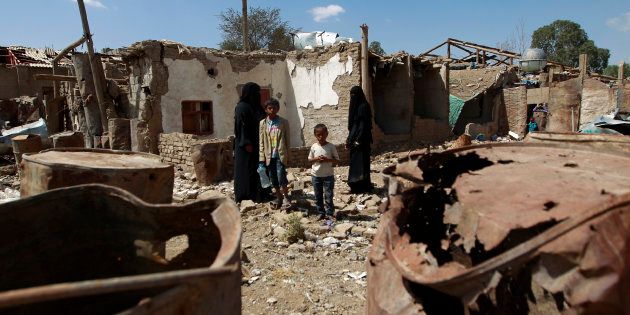
For nearly three years, the crisis in Yemen has been playing out in the shadows of ongoing regional conflicts — its victims' suffering largely hidden from public view. Today, however, the situation in Yemen has become a categorical humanitarian crisis. The country sits on the brink of famine and is contributing to what UN Under-Secretary-General for Humanitarian Affairs and Emergency Relief Coordinator Stephen O'Brien called "the largest humanitarian crisis since the creation of the UN."
The current conflict in Yemen began on 21 September 2014, with the Houthis, a broad national political movement, seizing the government's headquarters in Yemen's capital, Sana'a, after years of friction and distrust. On 25 March 2015, the Saudi-led coalition began an offensive on the Houthi fighters in a widely criticized campaign that pushed the already war-torn country into further disarray. The conflict is now widespread, with much of Yemen and its population caught in it.
Out of Yemen's population of nearly 29 million, 18.8 million people require some sort of humanitarian support. A further 10.3 million people are in need of urgent assistance to survive. 17 million people are food insecure, with seven million people unsure of where their next meal might come from, if it even does. More than three million people have fled their homes, public infrastructure and services are no longer functional and less than half of Yemen's health centres are able to operate, with life-saving medical supplies and equipment at a severe shortage.
A child under five dies every ten minutes from preventable causes, and 80 per cent of Yemen's children (9.6 million) need humanitarian assistance.
For Sadeq al-Jabri, a medical doctor and head of the kidney dialysis department at the military hospital in Sana'a, turning away patients due to limited basic supplies - everything from oxygen and insulin to medicines for kidney dialysis and chemotherapy — has become the norm. "We're facing an especially acute shortage of medicines for patients who suffer from kidney dialysis," he said. "We're no longer able to treat people adequately."
Children always bear the largest burden of any conflict. As the world's most vulnerable population, children can experience decades of trauma and suffering, affecting not only themselves but also future generations. As a result of the ongoing man-made conflict and worsening situation, a child under five dies every ten minutes from preventable causes, and 80 per cent of Yemen's children (9.6 million) need humanitarian assistance. Access to safe water is challenging and malnutrition is rapidly increasing. The lack of proper sanitation increases the threat of water-borne diseases such as cholera.According to UNICEF Director for the Middle East and North Africa Geert Cappelaere, the disease is spreading among Yemen's children at an alarming rate. "Most areas of the country are affected," he said.
Families are increasingly marrying off their young daughters to have someone else care for them, and often use the dowry to pay for basic necessities.
Cholera is mostly prevalent among those under the age of 15, which accounts for 41 per cent of the more than 300,000 reported cases of suspected cholera and acute watery diarrhea. As of July 2017, more than a quarter of the reported 1,700 deaths are children. This suffering has pushed Yemen's crisis to dire heights, with families embracing dangerous means of survival. Young girls, for instance, are being sold into marriage in exchange for food. "Families are increasingly marrying off their young daughters to have someone else care for them, and often use the dowry to pay for basic necessities," O'Brien said.
Despite the challenging environment in Yemen, as a result of more than two years of constant war, nearly 124 humanitarian partners consisting of 85 national non-governmental organizations (NGOs), 30 international NGOs and nine UN agencies have been able to reach more than 3.5 million people with some form of humanitarian assistance in all 22 of Yemen's governorates.
For many though, the situation is still getting worse, and humanitarian organizations are overwhelmed. "We are responding to a major crisis without having the basics," Cappelaere said. "The reality is incredibly dire."
Humanitarian organizations are often caught in the crossfire, and their efforts to deliver life-saving assistance and supplies continuously challenged by the continued fighting.
Greater attention must be paid to the suffering that is prevalent in Yemen. In order to prevent losing generations, we need to provide more help and support to the humanitarian organizations that are dedicating everything they have to preventing an already tragic situation from becoming even worse.